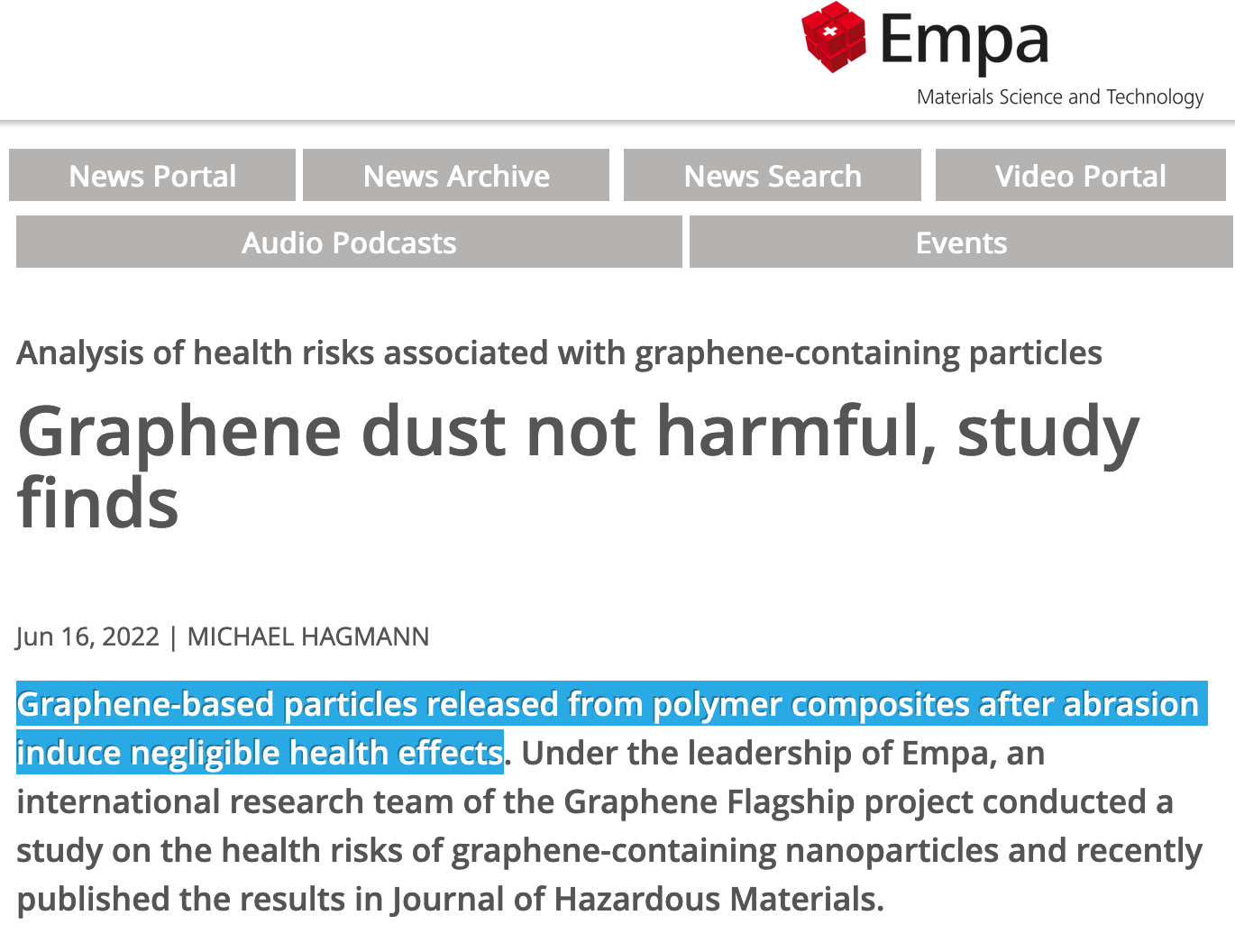Glyphosate 2.0: Scientists Test Graphene Compounds, Find Toxicity, Say It's Harmless 🤔
Study funded by EU’s Graphene Flagship.
Before we get to graphene, let’s briefly talk about glyphosate.
Glyphosate
On June 17, “in a historic victory for farmworkers and the environment, the U.S. Court of Appeals for the Ninth Circuit sided with Center for Food Safety … by overturning the Environmental Protection Agency's (EPA) decision that the toxic pesticide glyphosate is safe for humans and imperiled wildlife.” (source)
How many years and how many ruined lives did it take? Many. And even now, this doesn’t meant that glyphosate is going to vanish. First of all, it’s everywhere, from horizon to horizon. It is in the food, in the water, in the soil, you name it. Second of all, the nature of bullies is to only retreat when they are completely decimated and embarrassed. And even then, disgraced industry execs find ways to regroup, perhaps migrate to a different industry, and continue pushing unsafe products using same old marketing gimmicks (which is what happened when Big Tobacco execs moved to the food industry, which I wrote about in a recent story.)
Cynically, the glyphosate market is expected to grow.
What it will take is for all of us to get so disgusted with being poisoned that we’ll just spit them out and stop complying with this poisoning order. And yes, this includes the magical medical product whose safety record is by now so bad that it would make a stone cry.
(And for bitter giggles, here is a video of Patrick Moore saying glyphosate is so safe that one can drink a glass of it, and then refusing to drink it.)
Graphene
As far as graphene, it has a strong chance of becoming Glyphosate 2.0.
Graphene is “hot.” In the freedom community, it is talked about in the context of the COVID injections since independent researchers have identified graphene-based ingredients in vials. (On a side note, half-related to graphene, please see my earlier article and interview that detail the findings of researchers in New Zealand.)
But one doesn’t even need to be a conspiracy theorist to see graphene everywhere. It is everywhere! I will soon send a big article about it—but if you just google graphene, you’ll see that the way the wind is blowing, it already is—or is going to be—in batteries, car interiors, vaccines (or “vaccines”), medical sensors, walls, computers, clothing, etc. etc. And we are talking nanoparticles, meaning you’ll eat and drink and breathe them—and good luck getting it out of your system! It is real insanity.
There have been plenty of studies showing its toxicity—but a new one recently came out, and it’s quite astounding. It seems to be one of those studies where the conclusion just doesn’t match their own data.
The study, published in the Journal of Hazardous Materials, is titled “Hazard assessment of abraded thermoplastic composites reinforced with reduced graphene oxide.”
The researchers used cell lines representing different human organs and tested several graphene-derived or graphene-enforced materials. They found toxicity. They then they exposed three live mice to different graphene materials (poor mice). Again, they found toxicity. And then they concluded that the toxicity is negligible—and industry journals reprinted the findings optimistically. Sounds familiar? This is what happens when the scientists’ heads are in the cloud of soulless abstractions as opposed to in imagining what would happen if those materials were used on their children. 😜
The study was funded by EU’s Graphene Flagship project, which probably explains the conclusion.
Let’s look at the study, keeping in mind the following points:
Earlier, limited, studies have shown that the observed toxicity of graphene materials varied from one type of material to another and additionally depended on the size of the particles, the “dose” of exposure, etc. The overall conclusion is “yes, it’s toxic” but the outcome of the standoff between the toxicity of graphene and the powers of the immune system depends on many factors.
In this particular study, the researchers note that the inflammation of the lungs mostly “resolves” by day 28. But how well does their model reflect what happens in real life? What exactly happens if one is exposed to a number of graphene materials every day, in multiple ways (food, water, air)? What if graphene exposure is piled on top of glyphosate exposure, exposure to electromagnetic pollution, and exposure to other synthetic materials and biomaterials, including the proverbial spike protein?
This entire graphene affair sounds like criminal negligence, and I am not even going into the surveillance applications of graphene materials and other murky areas.
A rhetorical question that I can’t help asking. Are graphene materials so safe and effective that the wealthy graphene investors would gladly expose their own children to the novel nanoparticle-leeching materials? I have my doubts. There are usually different safety standards for the lords and for the peasants.
Now to the study.
ABSTRACT
Graphene-related materials (GRMs) are subject to intensive investigations and considerable progress has been made in recent years in terms of safety assessment. However, limited information is available concerning the hazard potential of GRM-containing products such as graphene-reinforced composites. In the present study, we conducted a comprehensive investigation of the potential biological effects of particles released through an abrasion process from reduced graphene oxide (rGO)-reinforced composites of polyamide 6 (PA6), a widely used engineered thermoplastic polymer, in comparison to as-produced rGO. First, a panel of well-established in vitro models, representative of the immune system and possible target organs such as the lungs, the gut, and the skin, was applied. Limited responses to PA6-rGO exposure were found in the different in vitro models. Only as-produced rGO induced substantial adverse effects, in particular in macrophages. Since inhalation of airborne materials is a key occupational concern, we then sought to test whether the in vitro responses noted for these materials would translate into adverse effects in vivo. To this end, the response at 1, 7 and 28 days after a single pulmonary exposure was evaluated in mice. In agreement with the in vitro data, PA6-rGO induced a modest and transient pulmonary inflammation, resolved by day 28. In contrast, rGO induced a longer-lasting, albeit moderate inflammation that did not lead to tissue remodeling within 28 days. Taken together, the present study suggests a negligible impact on human health under acute exposure conditions of GRM fillers such as rGO when released from composites at doses expected at the workplace.
SELECT EXCERPTS:
The aim of the present study was therefore to investigate the potential biological effects of particles released from a real-life GRM-enabled product (i.e., rGO-reinforced PA6 composites that will be soon found in the vehicle industry) through an abrasion process, and compare these effects to those induced by the rGO initially incorporated in the PA6 thermoplastic polymer matrix. Since GRMs and nanomaterials in general, can enter the human body via different routes (i.e., inhalation, ingestion, or dermal absorption) (Fadeel et al., 2018, Oberdörster et al., 2005, Pelin et al., 2018) we performed a multi-system and multi-endpoint in vitro human toxicity analysis (Fig. 1). Using well-established cell lines and cell-type specific endpoints, we first assessed the impact of abraded rGO-reinforced PA6 (PA6-rGO) composite materials on cells representative of key target organs related to the three main exposure routes (i.e., lungs, gut, and skin), and the immune system, our primary defense mechanism against foreign intrusion. As inhalation of airborne materials is a major concern at the workplace where such GRM-enabled products are likely to be processed, we further assess the possible effects of PA6-rGO composite materials on the lungs after single pulmonary exposure in mice. Based on this tiered approach combining in vitro and in vivo data, the objective of the present study was to provide a comprehensive, multi-laboratory hazard assessment of commercial GRM-enabled products at doses expected at the workplace.
The in vitro investigations demonstrated that pristine rGO was the material of highest concern amongst the tested materials, and that the immune cells and in particular the macrophages were the most responsive in vitro models both with respect to abraded materials (neat PA6 and PA6-RGO) and pristine rGO. Amongst all exposure routes, inhalation is the most rapid route of entry into the body and the only route in which macrophages would interact immediately, and without any intervening barrier, with the materials, should these respirable materials reach the alveoli
It should be noted that the unaligned significant response observed for one animal (out of 3) for all tested cytokines (and total cell number) after exposure to abraded PA6 at 28 days (Fig. 7, Fig. 8) was not anticipated.
In summary, pulmonary exposure to abraded PA6-rGO in mice induced a weak but not significant lung inflammation characterized by a transient influx of neutrophils and eosinophils in the alveolar space. In contrast, a high dose of pristine rGO induced a persistent presence of immune cells in the alveolar space, in particular macrophages associated with the clearance of materials, without affecting the overall resolution of inflammation with time. Importantly, this inflammation in the form of cell recruitment but without cytokine secretion was not associated with any tissue remodelling within the time-frame investigated.
The mice:
After anesthesia with 3% of isoflurane, mice were maintained on a slanted board and 30 µL of materials or vehicle was put at the basis of the tongue, allowing distribution of the materials into the lungs through physiological breathing. Mice (n = 3) were exposed by oropharyngeal aspiration to 15 µg (in 30 µL) of PA6-rGO (2.5% of rGO, which represents about 0.3 μg of rGO for 15 μg of PA6-rGO) or controls: neat PA6 (15 µg), rGO-0.3 µg (low dose, representing approximately 2.5% of the high dose) or rGO-15 µg (high dose) and vehicle (0.1% BSA in water). The applied dose of 15 µg per animal equals to 0.75 mg/kg, while 0.3 µg per animal equals to 0.015 mg/kg for animal weighing on average 20 g at the time of exposure. Outcomes were assessed at 1, 7, and 28 days after single exposure. At each time point, mice were euthanized by intraperitoneal injection with an overdose of pentobarbitone.
INDUSTRY REACTION:
Phew.
Comments from scientists welcome.
(I greatly appreciate your support, I depend on it.)






After very carefully constrained and time limited exposure to a well controlled amount of inhaled graphene in mice, the lung inflammation was "moderate" at 28 days, "but did not induce remodeling", which implies that it did not destroy structural components of the lungs that would need extensive repair.
Cellular elements could still be destroyed within this wording.
Additionally, work exposures in humans can be massive at once, or can go on for 28 years, not 28 days. The mouse model showed lung inflammation which was "moderate" in the estimate of researchers who are paid to find good news.
At the next step of telling the story, the researchers called these effects on the mice "mild", and by the time the article was sent out "Graphene dust not harmful" is the blanket statement.
Graphene has the potential to be much more harmful than asbestos, and in vastly smaller amounts, and not just by inhallation by miners and workers, but through skin, gut and potentially injection.
Graphene should clearly be treated at least as carefully as asbestos, but there's money to be made, and companies to be sold off before the medical complications get joined into class action suits.
"Business-cycle"
remember the kentile floors sign - you could see it from the smith/9th street station https://youtu.be/PsH5vzlFKNQ